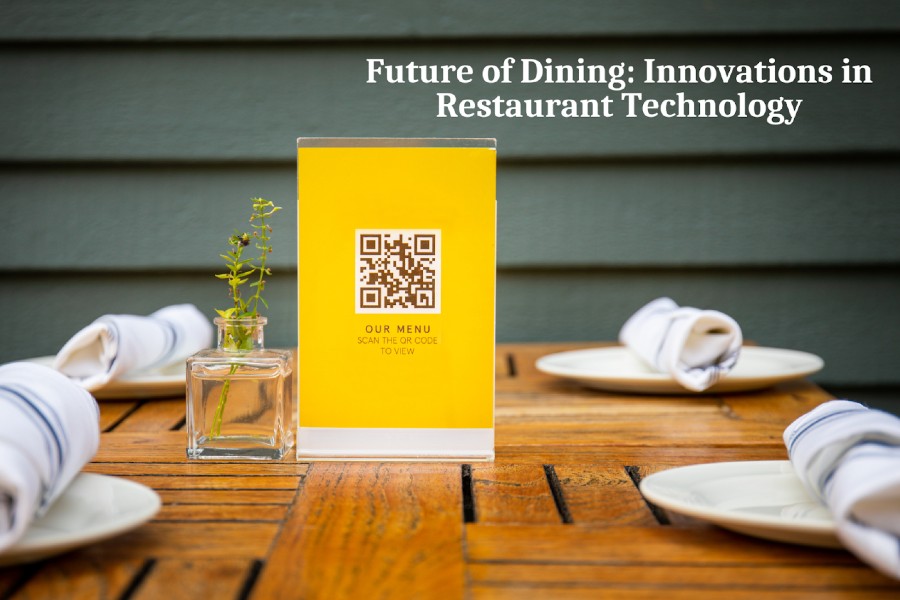
What if you could walk into a restaurant where robots prepare your meal, augmented reality shows you exactly how your dish will look, and AI predicts what you’ll love before you even open the menu?
This isn’t science fiction—it’s the cutting-edge reality of today’s restaurant industry.
In recent years, the restaurant industry has witnessed a technological revolution that’s reshaping how we dine out. From robotic chefs to augmented reality menus, these innovations are transforming both the operational efficiency of restaurants and the overall customer experience.
Let’s explore the exciting future of dining and the cutting-edge technologies driving this change.
The Tech-Driven Restaurant Revolution
The dining industry is evolving with technology at the forefront of this transformation. 60% of restaurants plan to make technology investments in 2024, while 76% of restaurant operators believe that technology gives them a competitive edge. This shift isn’t just about staying current; it’s about reimagining the entire dining experience.
The pandemic has accelerated this trend, with 4 in 10 restaurants planning to increase investments in equipment or technology to boost productivity in both the front and back of the house. As we delve into the specifics, we’ll see how these innovations are set to redefine our dining experiences.
Automation in Restaurant Operations
As we step into the kitchen of the future, we’re greeted by an unexpected sight: robotic chefs working alongside their human counterparts. This isn’t science fiction; it’s the reality of modern restaurant automation. Robotic chefs are revolutionizing kitchen operations. These high-tech culinary assistants can:
- Reduce human error
- Ensure precise measurements
- Maintain consistent quality standards
But don’t worry, human chefs aren’t being replaced. Instead, this technology allows them to focus on what they do best: creativity and innovation in culinary arts.
As restaurants embrace these innovations, the dining experience is set to become more interactive, efficient, and tailored to individual tastes. This promises a new era where technology enhances, rather than replaces, the traditional pleasures of dining out.
Using advanced natural language processing, https://www.slang.ai/ enables users to make inquiries using everyday language, enhancing the convenience and user-friendliness of the dining experience. Behind the scenes, artificial intelligence is transforming how restaurants manage their supplies. AI-powered inventory systems can:
- Predict demand patterns
- Optimize inventory levels
- Minimize waste
- Maximize profitability
This smart approach to inventory not only simplifies operations but also contributes to sustainability efforts by reducing food waste.
Enhancing the Customer Experience Through Technology
While automation is reshaping the back-of-house operations, technology is also revolutionizing the customer-facing aspects of dining. Gone are the days of static paper menus. Today’s restaurants are embracing interactive digital menus that offer:
- High-resolution photos
- Detailed descriptions
- Dietary filters
These smart menus can result in a 17-31% reduction in wait times, directly influencing customer satisfaction and table turnover. Augmented Reality (AR) and Virtual Reality (VR) are adding a new dimension to dining experiences. Imagine:
- Viewing your dish in 3D before making your selection
- Taking a virtual tour of the kitchen
- Experiencing themed dining environments
These technologies are turning meals into immersive experiences, appealing to a new generation of tech-savvy diners.
Smart Restaurant Management Systems
The dining experience is undergoing a radical transformation, thanks to cutting-edge technologies that are reshaping how customers interact with restaurants.
1. Interactive Digital Menus
Interactive digital menus are at the forefront of this customer-facing revolution. These high-tech replacements for traditional paper menus offer a range of benefits:
- High-resolution photos and 360-degree views of dishes entice customers and help them make informed choices.
- Descriptions, ingredient lists, and nutritional information are customized to health-conscious diners and those with dietary restrictions.
- Customers can easily customize ingredients or specify preparation methods.
- Multi-language support makes menus accessible to international guests.
- Menus can be instantly updated to reflect availability, specials, or price changes.
2. Personalized Dining
Artificial Intelligence is transforming the way restaurants understand individual preferences:
- Taste Analysis: AI algorithms analyze past preferences to suggest dishes a customer is likely to enjoy.
- Dietary Matching: The system can recommend dishes that align with specific dietary requirements or restrictions.
- Pairing Suggestions: AI can suggest complementary drinks or side dishes to enhance the dining experience.
- Personalized Promotions: Offers based on dining history can increase customer loyalty and spending.
3. Immersive Dining
AR and VR technologies are adding a new dimension to dining, creating immersive experiences that go beyond just eating:
- Virtual Menu Visualization: AR apps allow diners to see 3D renderings of dishes on their table.
- Interactive Storytelling: Learn about the history of a dish or take a virtual tour of the ingredient’s origin.
- Themed Environments: VR can transform the dining space, allowing customers to “eat” in exotic locations or fantastical settings.
- Chef Demonstrations: Watch virtual cooking demonstrations or “meet” the chef through AR applications.
These technologies not only enhance the dining experience but also serve as unique selling points, attracting tech-savvy customers and generating buzz for the restaurant.
Sustainability and Technology
As environmental concerns grow, restaurants are turning to technology to reduce their ecological footprint by investing in energy-efficient appliances that reduce power consumption, lower operational costs, and minimize environmental impact. The usage of smart appliances not only saves energy but also offers advanced features that improve cooking precision and consistency.
Additionally, technology plays a crucial role in sourcing sustainable ingredients, allowing restaurants to track the origin of ingredients, ensure ethical sourcing, and support local producers. By utilizing technology, restaurants can make more informed decisions about their supply chains, aligning with the growing consumer demand for sustainable dining options.
Challenges and Considerations
While the benefits of restaurant technology are clear, implementing these innovations comes with its own set of challenges. Integrating advanced technologies often requires significant upfront investment. However, the long-term benefits can outweigh the initial costs, with restaurants reporting reduced operational costs and reduced stress on staff after implementing new technology.
Introducing new technologies also means training staff to use them effectively, necessitating training programs, ongoing tech support, and regular system updates. Additionally, while many diners are excited about high-tech dining experiences, others may prefer traditional approaches, so restaurants must strike a balance to all preferences.
The Future of Restaurant Technology
As we’ve explored, the future of dining is not just coming; it’s already here. The integration of advanced technologies is fundamentally shifting how restaurants operate and how we experience dining out.
From robotic chefs and AI-powered inventory systems to AR menus and sustainable tech solutions, these innovations are reshaping every aspect of the restaurant industry. While challenges exist, the benefits of embracing technology are clear: increased efficiency, enhanced customer experiences, and improved sustainability.
As we look ahead, one thing is certain: restaurants that successfully adopt and adapt to these technological advancements will be the ones leading the industry into an exciting and innovative future.
FAQs
1. How secure are contactless payment methods in restaurants?
Contactless payment methods use encryption and tokenization to protect sensitive data. They are as secure as traditional payment methods, and their adoption enhances both convenience and safety for customers.
2. What impact do digital menu kiosks have on dietary restrictions?
Digital menu kiosks can display allergen information and filter menu items based on dietary preferences. Customers with specific dietary needs can easily find suitable options, enhancing their dining experience.
3. Can artificial intelligence (AI) replace human chefs in restaurant kitchens?
While AI enhances efficiency, it cannot replicate the creativity and intuition of human chefs. Chefs remain essential for culinary innovation, but AI can assist with tasks like inventory management and personalized recommendations.
Become a Harlem Insider!
By submitting this form, you are consenting to receive marketing emails from: . You can revoke your consent to receive emails at any time by using the SafeUnsubscribe® link, found at the bottom of every email. Emails are serviced by Constant Contact










